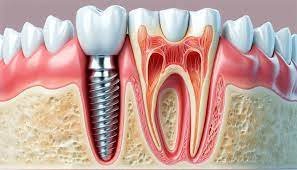Dental implants are an increasingly popular solution for individuals with missing or severely damaged teeth. Offering a long-term and natural-looking replacement, dental implants are designed to restore both the function and appearance of your smile. If you’re considering dental implants, understanding the procedure is crucial. Here’s a detailed, step-by-step guide to help you navigate the dental implant process.
1. Consultation and Initial Evaluation
The first step in the dental implant procedure is scheduling an initial consultation with your dentist or oral surgeon. During this visit, your dentist will evaluate your overall oral health, examine your gums, and determine if dental implants are right for you.
Your dentist will review your medical history, take X-rays, or possibly perform a 3D scan of your mouth to assess the health of your jawbone. Adequate bone density is essential for the success of the implant. If your jawbone is too thin or soft, your dentist may recommend additional procedures, such as bone grafting, to create a stable foundation for the implants.
The consultation also provides an opportunity for you to ask questions about the procedure, the recovery process, and any potential concerns. This is a great time to discuss the costs involved and explore financing options or insurance coverage.
2. Treatment Planning
Once your dentist has determined that dental implants are a suitable option, the next step is developing a personalized treatment plan. This plan will outline the number of implants required, the type of implants, and the timing of the procedure.
For patients with multiple missing teeth, your dentist may suggest full-arch implants or a bridge supported by dental implants, while others may only need a single implant. The treatment plan will be tailored to meet your unique needs, ensuring the best possible outcome.
Your dentist may also work with you to determine the most cost-effective approach, ensuring that the dental implant procedure fits within your budget while maintaining high-quality care.
3. Placing the Implant Posts
The first part of the dental implant procedure is the surgical placement of the implant posts, which act as artificial tooth roots. The procedure is typically performed under local anesthesia to numb the treatment area. For patients who are anxious or prefer to be sedated, options like intravenous sedation or nitrous oxide may be available.
During the surgery, your dentist or oral surgeon will make a small incision in the gum to expose the jawbone.
The titanium posts will fuse with the jawbone over the next several months in a process known as osseointegration. This is a critical step, as it provides a strong, stable base for the artificial teeth.
4. Healing and Osseointegration
Osseointegration is the process by which the titanium implants naturally fuse with the jawbone, creating a permanent and secure foundation for the new teeth. This phase of the dental implant procedure typically takes several months, ranging from 3 to 6 months, depending on your body’s ability to heal.
During this healing period, it’s important to follow your dentist’s aftercare instructions, which may include avoiding hard or chewy foods, refraining from smoking, and practicing good oral hygiene.
For patients who have undergone bone grafting, the healing process may take a bit longer, as the bone must first regenerate before the implants can integrate properly.
5. Attaching the Abutments
Once osseointegration is complete, the next step is to attach the abutments. These are small connectors that link the implant posts to the final restoration (e.g., a crown, bridge, or denture). During the abutment placement, your dentist will expose the implants and attach the abutments.
6. Taking Impressions and Designing the Restorations
After the abutments are in place, your dentist will take impressions of your mouth. These impressions will be used to create custom-made crowns, bridges, or dentures that match the shape, size, and color of your natural teeth.
7. Placing the Final Restorations
Once your permanent restorations are ready, your dentist will attach them to the abutments. This is the final step in the dental implant procedure. Depending on the number of implants, you may receive a single crown, a bridge, or a full set of dentures.
8. Post-Treatment Care and Maintenance
After the dental implant procedure, it’s important to follow a proper oral care routine to ensure the longevity of your implants and restorations. This includes regular brushing, flossing, and routine checkups with your dentist to monitor the health of your implants and surrounding tissues.
While dental implants are highly durable, they still require care and maintenance. Regular checkups allow your dentist to catch any issues early, such as gum disease or wear on your restorations.
Conclusion
The dental implant procedure is a multi-step process that requires careful planning, precision, and commitment to healing. By following your dentist’s advice and maintaining good oral hygiene, dental implants can provide a permanent and natural-looking solution for missing or damaged teeth. Whether you need a single tooth replaced or a full arch of teeth restored, dental implants can significantly improve both the function and aesthetics of your smile, allowing you to enjoy a better quality of life.
Read More ( Click Here )
















Leave a Reply